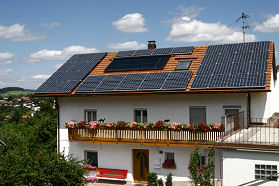
By Miriam Raftery
June 25, 2012 (San Diego) – A California Public Utilities Commission has brightened the future for solar energy in California. In a unanimous decision last month, the CPUC voted to nearly double the number of homes and businesses that will be eligible to participate in the state’s net metering program. With net metering, Net meter lets homeowners and business owners cut their utility bills by installing solar panels—and get credit for excess electricity that the send to the state’s power grid.
“Some utilities fought hard to block the CPUC from changing its net metering policy, but I was gratified to see the commission make a courageous decision that will continue California’s leadership in promoting solar power,” said Laura Wisland, senior analyst for clean energy at the Union on Concerned Scientists (UCS).
The ruling changes the way that the state’s net metering limit is calculated. Under the new calculations, the maximum total capacity of all the state’s solar rooftop systems will be raised to 5,285 megawatts from 2,464 megawatts—an increase that is enough to power 2.1 million homes, according to UCS.
That’s a powerful selling point for solar, since it helps defray the up-front costs of installation.
The decision to increase solar will not only reduce greenhouse gas emissions that contribute to global warming, but will also create jobs and boost the California economy. Already, the solar industry in California employs over 25,000 workers and has raised over $10 billion in private investment across the state. Solar energy installation jobs locally pay around $20 to $40 an hour.
In response to objections that the ruling could unfairly impact low-income homeowners or those who simply choose not to install solar panels, the CPUC also agreed to study impacts on those sectors.
Cost of solar has fallen sharply in recent months, while SDG&E continues to seek rate hikes for ratepayers with conventional power, making conversion to solar power even more attractive.
For information on the change in state law, see http://blog.ucsusa.org/more-solar-roofs-in-california
For information on SDG&E’s net metering program, see http://regarchive.sdge.com/nem/about.shtml







Recent comments